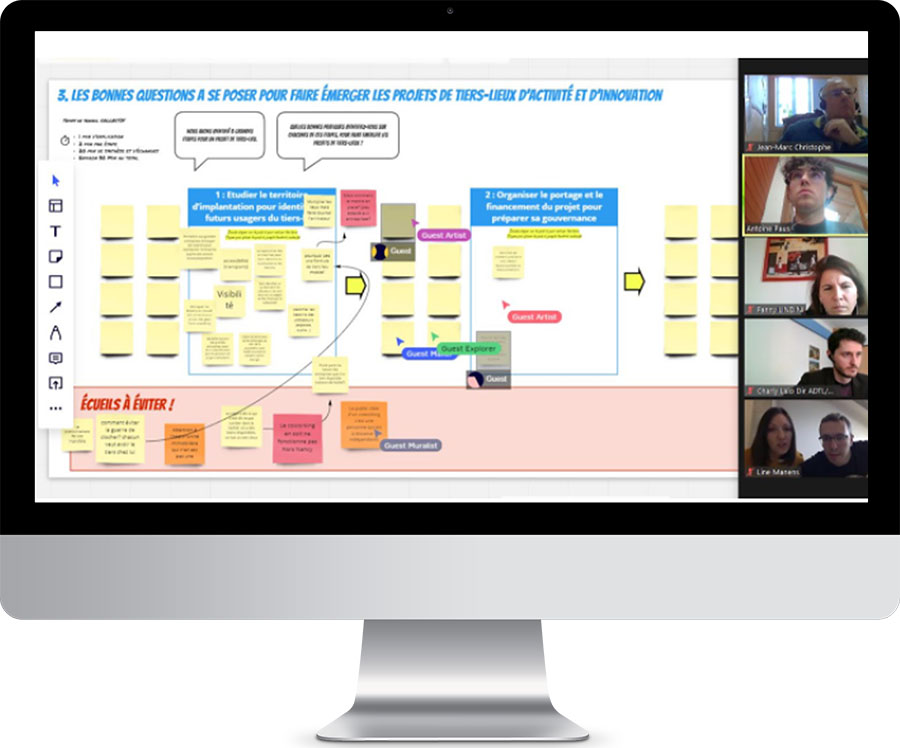What is a third place? A third place is a physical space for "doing things together," most often supported by digital technologies. Its success depends on the following four fundamental elements: a place, a community, a facilitator, and shared resources.
What are the specific features of a rural third place?
Establishing a third place in a rural setting requires understanding its specific characteristics compared to third places in densely populated and urban areas. Indeed, a third place is defined by its target audiences and their needs, and as such the rural context stands out strongly from the urban environments of historical deployment of third places:
A rural third place will not necessarily seek to achieve a form of specialization, which is sometimes necessary in an urban environment, but rather to address the local needs of the population: local services (post office, grocery store, etc.), community (café, living space, cultural space, etc.) and access to a third place of work (coworking). This is why a rural third place will stand out from its urban cousins in the following aspects:
- Third places in rural or sparsely populated areas are small structures that primarily seek to address a local community: a core of a few entrepreneurs, artisans, self-employed workers, or simply citizens (groups of friends, associations, etc.);
- Rural third places will have fewer potential users but potentially more uses. Indeed, the needs of certain areas are diverse, so a rural third place could be a grocery store/relais/coworking space, which potentially requires more storage and living space than workspace. The all-coworking model will not be enough to sustain a rural third place, even if it remains attractive to some users who wish to stay close to home and avoid traveling to major cities. Sustaining a rural third place will require creating a living space that provides a central location for local residents. As such, the average attendance at a coworking space in a rural setting does not exceed 3 to 10 users.
- In rural areas, the economic models of these structures are therefore more complex to define: the right activities, services, and partners (private or public) must be found to achieve economic balance in the medium term. Strong community support is necessary for this type of project, whether financial, in terms of facilitation, or assistance with project development. Thus, rural third places are also spaces for innovation in terms of public/private governance and often take the form of cooperatives or general interest associations.
- Rural third places stand out for their strong potential as a territorial development tool: they contribute to the revitalization of the territory, offer essential services to residents, and help recreate a sense of community.
These specific features make this type of project a great development opportunity for the community. But this will require creativity, openness to innovation, and a concerted approach from the public authorities. Indeed, in order to achieve sustainability in this type of project, the community will have to build a community around the site and mobilize residents, entrepreneurs, and local associations.
Some examples of third places in rural areas:
- Small rural coworking center in former municipal premises, combined with local services or support for entrepreneurs(combining a classic coworking photo or one with the outdoors if possible)
- Fablab aimed at the general public or specializing in the digital transformation of artisans and the provision of specific tools (classic fablab photo)
- Rural third-place showcases local expertise (training, demonstrations on the jobs of tomorrow, seminars) and is also part of a short supply chain approach (sale of local products, links with AMAPs)photo short supply chains / small producers
- Rural third-place for digital mediation serving individuals or businesses,photo digital mediation
- Rural third-place “guinguette”: based on an offer of entertainment and catering, it becomes the place of festivities and meetings of the territoryphoto guinguette
The rural third-place model remains hybrid; it can draw inspiration from its different categories to offer several solutions based on the needs identified in a given area.
How can you get support in building your rural third-place?
Tactis has been supporting numerous local authorities in their territorial revitalization projects for several years through innovative third-place initiatives. Tactis consultants can assist you with the following stages of your project:
-
- Defining the positioning of the third place, in relation to the needs and characteristics of your area: Diagnosis of the local context, cartographic modeling, quantitative sociological surveys, definition of a positioning strategy for the third place;
- Identifying local partners and stakeholders of the third place: Awareness-raising, facilitation, and unification of local stakeholders
- Facilitation of local participatory workshops to co-construct the third-place project and find partners
Facilitation of online workshops by Tactis on the emergence of third places in South Meurthe-et-Moselle

- Defining the third-place business model: developing business plans, assessing revenues and optimizing investments, analyzing financial risks, identifying public and private funding, preparing financing applications, etc.
- Setting up the legal structure and defining the third-place governance: choosing the appropriate legal vehicle, drafting the bylaws of structures (associations under the 1901 law, SCIC, SPL, etc.), defining the related governance structure, and developing a multi-year ramp-up plan.
- Search for funding sources: State, region, local authorities, Europe, private actors, etc.

Nicolas Potier
Contact Nicolas Potier
Do you have a question about rural third places? Need some clarification regarding a future project? Send an email to Nicolas Potier, Associate Director of Tactis.

